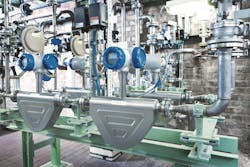Aspects of instrument safety that should be considered in chemical plants
Safety is more than just SIL (Safety Integrity Level) but it comes up first in most discussions when safety is mentioned. In fact, plant safety includes several factors such as hazardous approvals, occupational and process safety, and cybersecurity, on top of functional safety (e.g. SIL IEC 61508/61511).
Here is a brief overview of the International Electrotechnical Commission (IEC) Standards.
- IEC 61511 deals with proven in use equipment. For example, a vendor and/or an end user utilizes the data (e.g. failure rates) they have on hand for an instrument. Usually end users have a tremendous amount of valuable information for a particular instrument’s reliability in specific applications at their facility.
- IEC 61508 deals with instruments that are designed for safety applications where a third-party equipment testing institution such as UL, TUV or EXIDA attests to having evaluated them for compliance. They provide a certificate for the instruments in question confirming they can be specified and used as part of a Safety Instrumented Function (SIF).
There are two main types of failures considered — safe and dangerous. Each failure developed during testing or operation is analyzed to identify whether it is safe or dangerous. The dangerous undetected (Du) failures are of particular interest as they are dangerous failures which remain undetected. Therefore, Du failures are included in the Probability of Failure on Demand (PFD) calculation on the testing certificates.
When designing a SIF loop — which consists of a sensor, logic solver and actuator) — one needs to consider not only the individual items’ safety but also the availability of a SIF.
For example, in a SIL-rated Coriolis liquid flow application this may mean designing a system that has redundant sensors. However, for each application, care should be taken on whether you opt to use a homogeneous-redundant model or diverse-redundant model. For example, if you opted for a homogeneous-redundant model and both Coriolis meters are not capable of handling entrained gas, then the SIF would experience numerous trips every time air or gas flow increased in the liquid line. The solution here would be to use a redundant Coriolis model where both meters can handle entrained gas. In this fashion, you can operate with a one out of two voting (1oo2). Alternatively, you might consider a diverse-redundant model wherein one of the two Coriolis meters could handle entrained gas. In this case you would have the SIF trip on 2oo2, for example.
For additional info on how to design a SIF loop OR for other safety related questions please visit KROHNE’s dedicated safety website at https://krohne.com/en/trends/safety
About KROHNE
KROHNE is a worldwide technological leader in the development, manufacture and distribution of accurate, reliable and cost-effective measuring instruments for the process industries. KROHNE focuses on forming partnerships with its customers to provide them with the most reliable and innovative solutions available in the marketplace. For more information about KROHNE’s complete line of measuring instrumentation for the process industries, contact KROHNE at 1-800-FLOWING (978-535-6060 in MA); email: [email protected], X, Facebook, LinkedIn, or visit www.us.krohne.com.
